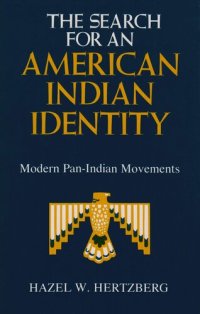
Ebook: The Search for an American Indian Identity: Modern Pan-Indian Movements (The Iroquois and Their Neighbors)
Author: Hazel Hertzberg
- Year: 1981
- Publisher: Syracuse University Press
- Edition: 1
- Language: English
- pdf
American Indian national movements, asserting a common Indian interest and identity as distinct from tribal interests and identities, have been a significant part of the American experience throughout most of this century, but one virtually unknown even to historians. Here for the first time Pan-Indian movements are examined comprehensively and comparatively. The opening chapter provides the historical background for the development of modern Pan-Indianism. The first major Pan-Indian reform organization, the Society of American Indians (SAI), was founded in 1911. Led by middle-class, educated Indians. The SAI adapted many of the reform ideas of the Progressive Era to Indian purposes. The SAI rejected the old dream of restoring tribal cultures and worked instead for an Indian future identified with the broader American society, to be realized through education and legislation. During the twenties, the SAI declined and the direction of Pan-Indian efforts shifted. Pan-Indian fraternal movements arose that were more in keeping with the spirit of the times than was reformism. Based in towns and cities, the fraternal orders and social clubs provided a means for urban Indians to retain or regain an Indian identity. In the meantime, an Indian religious movement, the peyote cult, spread far beyond its Oklahoma heartland, gaining Indian adherents in many parts of the country. Abandoning the messianic hopes of earlier Pan-Indian religions, the peyote cult developed as a religion of accommodation, a blending of elements from many tribes and from Christianity as well. In 1918 Oklahoma peyotists incorporated the first Native American Church as a defense against a campaign to outlaw the use of peyote by Indians. During the succeeding decade churches were organized in other states. The Indian New Deal, which radically changed governmental policy, provided a new context for Pan-Indianism. The author examines briefly developments since 1934. Her concluding chapter places the various Pan-Indian movements in historical perspective. The research for this study included extensive use of a wide variety of primary sources—journals published by 1he Indian groups, collections of documents and letters, governmental records, and interviews with Indians, anthropologists, and government officials.
Download the book The Search for an American Indian Identity: Modern Pan-Indian Movements (The Iroquois and Their Neighbors) for free or read online
Continue reading on any device:

Last viewed books
Related books
{related-news}
Comments (0)